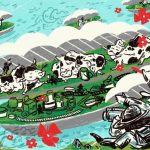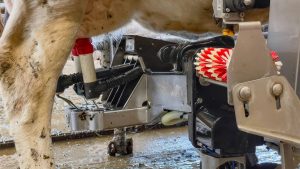“We cannot grow on our farms without fertilizing,” Park said. Indiana County doesn’t enjoy the deep, nutrient-rich soil of the Corn Belt, so chemical supplements are necessary.
“For us, growing 600 acres of grain, we’re talking about 50 tons of nitrogen. The same things have happened with phosphorous and potash. And you can get potash from utilization of manure, but you never have enough cow manure to cover the acres we have,” Park said.
Ron Learn, president of the Indiana County Farm Bureau, connected the jump in fertilizer costs with the war in Ukraine.
“The biggest hit on the farm side is a lot of fertilizer has been imported from Russia and Ukraine, but now because of regulations in our country … we’re producing more nitrogen and ammonia fertilizer, but still three-quarters of that is imported from other countries,” Learn said.
Most costs of developing the year’s product begin with the “inputs” that can’t be changed, said Learn, a Green Township dairy farmer. Learn traces his family’s operation to the mid-1800s.
“There isn’t a whole lot we can do to mitigate that, really. What do you do? If you cut back on input, you cut back on production,” Learn said. “Commercial trucks deliver supplies and take raw milk. Now every truck visit has a fuel surcharge. Gasoline and diesel doubled in last couple of years.”
Also unavoidable: higher interest rates on money that farmers borrow each year. The loans pay for startup materials each spring; they’re repaid as products go to market and return revenue later in the year.
Park said he didn’t even begin to calculate ways to reduce what he pays for diesel to run his farm machinery.
“It doesn’t pay for me to even look at the fuel slip. I just pay the bill. We can’t operate without it,” he said. “When your crop is standing out in the field, you have to take it off to make your money off it. So you’re going to have to sacrifice, and burn that high-dollar fuel to get to it.”
Taking a gamble, Learn said, was a decision to delay major equipment purchases that ordinarily would have been due this past year.
While some of the costs of doing business have increased 200 percent to 300 percent for Indiana County farmers, what has kept grocery store prices from rising 50 percent or more has been farmers’ finding ways to buy less, buy smarter or not buy at all.
Taking on the roles of scientist and economist, Park has found ways to reduce the hit of fertilizer prices.
“I go around and soil sample all our farms. Every farm gets a dozen soil samples pulled and I send them away to get tested,” Park said. “Five years ago I could just go spread fertilizer. It didn’t matter whether I spread it on soy beans or corn or small grain. I just knew I had a set rate.
“But when fertilizer doubled in price, I had to look at how much extra it was going to cost me. So on some farms that have richer soils that don’t require it, I can use a little less. On the farms that need a little more, I used what I saved on others.”
Park said he had done spot analyses in the past but never on a massive scale that he did in fall 2021. He spent two full days with his father collecting the soil samples, then put in a half a day with his mother completing required paperwork.
“It’s all time and you can’t put a price on that, but I was looking at how I was going to save on my fertilizer bill. If it took me two days or three days to do it, it was going to be worth it.”
That investment of time paid off.
“I was a little nervous going in, where I skimped on fertilizer, would my yields suffer big time? But they stayed where they were, my soil tests were accurate,” Park said. “It saved us 20 tons of fertilizer. At $800 to $900 a ton, that adds up in a hurry. That was one thing we adjusted to compensate for the increase.”
Park said he applied more science to reducing the costs of drying crops after harvesting. He uses natural gas to run driers, which require one-third the amount of time as leaving crops out in the field to dry naturally.
“We don’t try to dry grain when it’s really cold, because that sucks up a lot of gas. So I try to time it better and get the crops off when it’s warmer and not have a big gas bill to pay at the end of the season,” Park said.
Learn and Park said they hadn’t marked up their own prices to make up for the higher costs they had to bear in 2022.
Milk prices are set by the Pennsylvania Milk Marketing Board, which abides by federal regulations and considers “a big spider web” of up to a dozen other factors to determine prices of whole milk, cheese, whey and all other dairy products, Learn said.
The board’s rates in 2022 uncharacteristically favored the farmers.
“Up until several years ago, we went through five years of the lowest margins in a long time,” Learn said. “This past year … has been an all-time gross price we’re being paid, so that is what’s keeping us going, these high prices — at least on our operation.”
High demand for ethanol has meant high prices paid for corn this past year.
“We do sell some to feed mills but we are very, very fortunate to have the ethanol plant in Clearfield,” Park said. “They pay very good for corn and have been very good to deal with for us. I watch the grain and cattle markets and it’s a broad spectrum. They have the Chicago Board of Trade prices on what they would be getting out west, but you’d be amazed at how much more we’re getting paid for corn here because of the ethanol plant.
“Do I think we get paid enough for our corn? No, because I know what it takes to grow it. But it’s like the stock market. You take a chance. You may sell it today and it may gain an extra 30 cents by lunchtime or you could lose a dollar on it. You just have to swallow what comes to you.”
Park said 75 percent of market steers he produces go to the JBS Beef Plant in Souderton, Montgomery County, and the remainder, about 50 to 60 head a year, are sold locally for freezer beef.
“People buy quarters or halves or wholes. Now I did increase our price a little bit on that to compensate,” Park said. “We were charging the same for years, $2.25 a pound across the board — that was for steaks, the whole nine yards. But I had to jack that up to $2.50” to make up for the price paid for calves at the start of the year.
“But when I went to the store and saw at the meat counter what they are charging versus what we’re getting paid — I thought we could probably bump it a little bit and I didn’t think people would” have a problem.
The national consumer price index for December decreased by 0.1 percent, led by declines in prices for gasoline and other fuels that countered continuing, but moderating, increases in food and most other categories of spending. Because gasoline prices depend on crude oil prices that reflect international political factors as much as supply and demand, neither Learn nor Park expected prices to fall to pre-2021 levels.
But both predicted some of their costs to dial back — but not all.
“Seed corn took another $15 hit this week,” Park said. “I used to spend $250 a bag, now it’s $265 a bag.
“But with fertilizer — in 2019 and 2020, some of our chemical mixes for herbicides on corn and beans, we’d buy in bulk at $10 to $11 a gallon, some others for $15 a gallon,” Park said. “Round Up last year was up to $60 a gallon. But two days ago I paid $25 a gallon, so it has come back down but I’m never going to see that $11 a gallon Round Up again. The chances of us ever seeing it dirt cheap again are long gone.
“I don’t think we’re going to see $400 fertilizer again. I hate to say this but I think this general ballpark will be our new normal. I think the days of buying cheap feeder calves and cheap fertilizer, we’re not going to see them anymore.”
“There are some early indications of fertilizer backing off a bit, but not back to where it was. And fuel may back off a little bit but crude oil may go back up this year,” Learn agreed. “And milk prices are expected to be lower this year.”
But on the other hand, Learn said, governments in European nations and New Zealand, which have been major exporters of milk, are ordering reductions in the numbers of farms and cows in production, saying the high production is environmentally harmful and contributes to climate change.
He didn’t speculate on the effect on Indiana County dairy farmers, suggesting that the area is too distant to be able to supply perishable milk products to areas where supplies may be thinned by decreased production.
Regardless of politics, wars and climate-control policies, one major and timeless factor still has the greatest bearing on farmers’ success.
“At the end of the day, all of our crops rely on Mother Nature. That’s who holds the ace,” Park said. “We don’t irrigate, so you’re relying on getting the right amount of rain at the right times to get a good crop.”


























